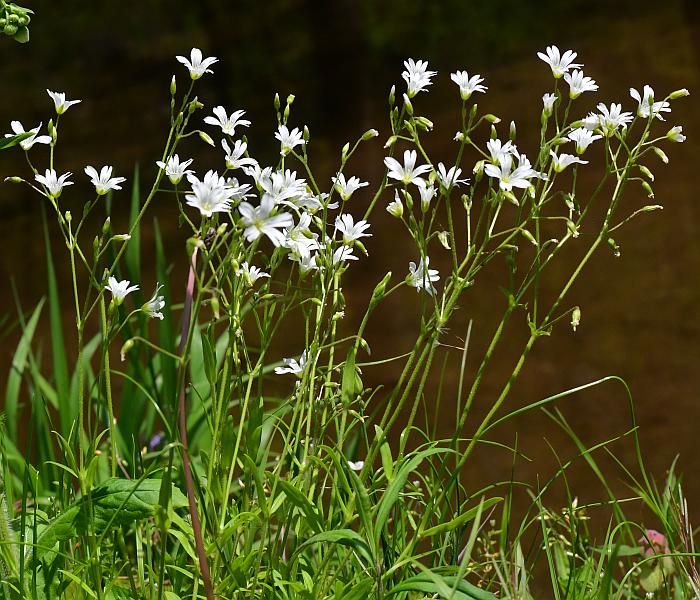Cerastium velutinum Raf.
Field Chickweed

Native
CC = 4
CW = 3
MOC = 12
© SRTurner
Cerastium velutinum Raf.Field Chickweed | |
 |
Native CC = 4 CW = 3 MOC = 12 |
© SRTurner |
|
Family - Caryophyllaceae Habit - Taprooted perennial, sometimes rhizomatous. Stems - Erect or ascending from a sprawling base, to 40 cm, branched, densely pubescent with both glandular and nonglandular hairs.
Leaves - Opposite, simple, entire, sessile, 2.0-6.5 cm long, spatulate to narrowly ovate, usually bluntly pointed, pubescent.
Inflorescence - Flowers in open panicles, the stalks 1.2-3.4 cm long, 2-4 times as long as the sepals, erect or ascending, at fruiting usually hooked near the tip, densely pubescent with both glandular and nonglandular hairs, only the uppermost bracts with narrow, thin, white to translucent margins, the others green and herbaceous.
Flowers - Sepals 5, 4.5-8.5 mm long, narrowly elliptic, sharply pointed, green with membranous margins, densely pubescent with stalked glands, these not extending past the sepal tips. Petals 5, 10-15 mm long, 2 times as long as the sepals, deeply 2-lobed (1/4-1/3 of the way) at the tip. Stamens 10. Styles 5.
Fruits - Cylindrical capsules 10-14 mm long, about 2 times as long as the sepals, curved. Seeds 0.8-1.2 mm wide, the surface tuberculate, brown.
Flowering - April - June. Habitat - Streambanks, forest openings, pastures, roadsides. Origin - Native to the U.S. Lookalikes - Cerastium arvense. Other info. - Plants in the genus Cerastium are usually small and weedy looking, but this is an exception. It is without a doubt the showiest member of the genus in Missouri and certainly the largest-flowered. It is found mostly in the eastern Ozark region of the state. Its range in the U.S. is very limited. There are populations in Missouri, Illinois, and Pennsylvania, but it absent or considered rare everywhere else. This is a beautiful plant and would make a good garden subject. Photographs taken at Silver Mines Recreation Area, Madison County, MO, 3-19-2012, 4-3-2016, and 4-13-2017, 4-28-2020, and 5-21-2020 (SRTurner). |